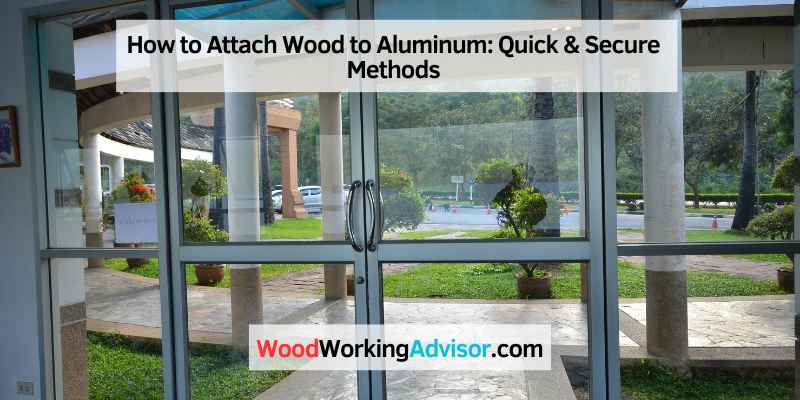To attach wood to aluminum, use self-tapping metal screws or adhesive specifically designed for bonding metal and wood. These methods provide a secure and durable connection between the two materials.
When working with wood and aluminum, it’s essential to ensure a strong and reliable attachment. Whether for DIY projects or industrial applications, knowing how to securely join these materials is crucial. We will explore effective methods for attaching wood to aluminum, covering both mechanical fastening and adhesive bonding techniques.
By understanding and implementing these methods, you can achieve a sturdy and long-lasting connection between wood and aluminum for various projects.
Introduction To Wood And Aluminum Bonding
Wood and aluminum bonding is a crucial process when it comes to attaching wood to aluminum. This blog post will explore effective techniques and strategies for achieving a strong and durable bond between these two materials, providing valuable insights for any DIY enthusiast or professional.
Wood and aluminum are two materials that are commonly used in various applications. While wood is a natural material that is known for its warmth and beauty, aluminum is a durable and lightweight metal that is preferred for its strength and resistance to corrosion. In many cases, these two materials are used together to take advantage of their unique properties. In this post, we will discuss how to attach wood to aluminum and explore the benefits of combining these materials.
Benefits Of Combining Wood With Aluminum
Combining wood with aluminum can offer several benefits, including:
- Strength: Aluminum is a strong material that can support heavy loads, while wood is a sturdy material that can withstand stress and strain. When these materials are combined, they create a structure that is strong and resilient.
- Resistance to Corrosion: Aluminum is highly resistant to corrosion, making it ideal for outdoor applications. Wood, on the other hand, is susceptible to rot and decay when exposed to moisture. By combining these materials, you can create a structure that is both durable and resistant to the elements.
- Aesthetics: Wood and aluminum offer different aesthetic qualities. Wood is warm and natural, while aluminum is sleek and modern. By combining these materials, you can create a unique and visually appealing design.
- Cost-Effective: Wood is often less expensive than other building materials, such as steel or concrete. By combining wood with aluminum, you can create a cost-effective solution that is both strong and durable.
Common Applications
Combining wood with aluminum is a popular choice for various applications, including:
| Application | Benefits |
|---|---|
| Decking | Durable, resistant to corrosion, cost-effective |
| Furniture | Aesthetically pleasing, strong, cost-effective |
| Doors and Windows | Durable, energy-efficient, aesthetically pleasing |
| Signage | Visually appealing, durable, cost-effective |
By understanding the benefits of combining wood with aluminum and the common applications, you can explore different ways to incorporate these materials in your projects. Whether you are building a deck, designing furniture, or creating signage, wood and aluminum bonding can offer a unique and effective solution.
Essential Tools And Materials
Attaching wood to aluminum requires essential tools and materials such as drill bits, screws, bolts, and rivets. It’s important to use the appropriate size and type of fastener to ensure a secure and long-lasting connection between the two materials.
When it comes to attaching wood to aluminum, having the right tools and materials is essential to ensure a secure and long-lasting connection. In this article, we’ll cover the essential tools and materials you’ll need to get the job done right.
Choosing The Right Adhesive
When choosing an adhesive to attach wood to aluminum, it’s important to select a product that is specifically designed for this purpose. Look for an adhesive that is strong enough to bond the two materials together, but also flexible enough to allow for any expansion or contraction that may occur due to changes in temperature.
Some popular options for attaching wood to aluminum include:
- Epoxy: A two-part adhesive that creates a strong, durable bond.
- Polyurethane: A flexible adhesive that can withstand vibrations and movement.
- Acrylic: A water-resistant adhesive that is easy to use and dries quickly.
Required Clamping Tools
To ensure a strong bond between the wood and aluminum, clamping tools are necessary to hold the two materials together while the adhesive sets. Some common clamping tools used for attaching wood to aluminum include:
- C-clamps: Used to hold the wood and aluminum together while the adhesive dries.
- Spring clamps: Ideal for smaller projects or when working in tight spaces.
- Bar clamps: Used for larger projects or when more clamping pressure is needed.
Personal Protective Equipment
When working with adhesives and clamping tools, it’s important to wear the appropriate personal protective equipment to prevent injury. Some essential PPE items to consider include:
- Safety glasses: To protect your eyes from any flying debris.
- Gloves: To protect your hands from any chemicals or sharp edges.
- Respirator: To protect your lungs from any fumes or vapors.
By using the right adhesive, clamping tools, and personal protective equipment, you can attach wood to aluminum with confidence and create a strong, long-lasting connection.
Surface Preparation Techniques
Cleaning And Degreasing
Cleaning and degreasing the surfaces of wood and aluminum is crucial to ensure proper adhesion. Before attaching the wood to aluminum, make sure to remove any dirt, dust, grease, or other contaminants that may hinder the bonding process. Here are some steps to follow:
- Start by wiping the aluminum surface with a clean cloth to remove loose debris.
- Next, use a mild detergent or a specialized cleaner to remove any grease or oil residue from the aluminum surface. Apply the cleaner using a soft brush or cloth, and scrub gently.
- Rinse the aluminum surface thoroughly with water to remove any remaining cleaning solution.
- Allow the aluminum surface to dry completely before moving on to the next step.
- For the wood surface, use a clean cloth or brush to remove any loose particles and dust.
- If there are any stubborn stains or residues on the wood, you can lightly sand them off using fine-grit sandpaper.
Sanding For Enhanced Adhesion
Sanding the surfaces before attaching wood to aluminum helps to create a rougher texture, which promotes better adhesion. Follow these steps for effective sanding:
- Start by selecting an appropriate grit sandpaper. For most applications, a medium-grit sandpaper (around 120-150 grit) works well.
- Using the sandpaper, gently sand the aluminum surface in a circular or back-and-forth motion. This will help to create small scratches on the surface, allowing the adhesive to grip more effectively.
- Ensure that you sand the entire surface evenly, paying extra attention to any smooth or glossy areas that may hinder adhesion.
- After sanding the aluminum, wipe away any dust or debris using a clean cloth.
- For the wood surface, sand it in the same manner as the aluminum, using the same grit sandpaper.
- Once again, remove any sanding residue from the wood using a clean cloth.
By following these surface preparation techniques, you can significantly improve the adhesion between wood and aluminum, ensuring a strong and durable bond.
Adhesive Application Process
Attaching wood to aluminum can be a challenging task, but with the right adhesive application process, you can achieve a strong and durable bond. In this section, we will discuss the key steps to follow when applying adhesive to join wood and aluminum together.
Applying The Adhesive Evenly
To ensure a successful bond between wood and aluminum, it is crucial to apply the adhesive evenly. Follow these steps:
- Clean the surfaces: Start by cleaning both the wood and aluminum surfaces thoroughly. Remove any dust, dirt, or grease that could hinder the adhesion process.
- Choose the right adhesive: Select an adhesive that is suitable for bonding wood and metal. Epoxy-based adhesives are commonly used for this purpose.
- Prepare the adhesive: Follow the manufacturer’s instructions to prepare the adhesive. This may involve mixing two components or activating the adhesive in a specific way.
- Apply the adhesive: Using a suitable applicator, spread the adhesive evenly on either the wood or aluminum surface. Ensure that the adhesive layer is uniform and covers the entire area that will be bonded.
- Join the surfaces: Press the wood and aluminum surfaces together firmly, aligning them properly. Apply pressure for the recommended duration specified by the adhesive manufacturer.
- Allow curing time: Let the adhesive cure for the recommended time. Avoid disturbing or stressing the bond during this period.
Avoiding Common Mistakes
While applying adhesive to attach wood to aluminum, it is important to avoid common mistakes that could compromise the bond. Here are some key things to keep in mind:
- Do not rush the process: Take your time to clean the surfaces properly, choose the right adhesive, and follow the manufacturer’s instructions for preparation and application.
- Avoid excessive adhesive: Applying too much adhesive can lead to messy results and may not necessarily improve the bond. Follow the recommended amount specified by the adhesive manufacturer.
- Ensure proper alignment: Make sure the wood and aluminum surfaces are aligned correctly before pressing them together. Any misalignment can weaken the bond.
- Allow sufficient curing time: Rushing the curing process can result in a weaker bond. Give the adhesive enough time to fully cure and achieve its maximum strength.
- Consider surface preparation: In some cases, roughening the surfaces slightly with sandpaper or using a primer can enhance adhesion. Check the adhesive manufacturer’s recommendations for surface preparation.
By following these guidelines and paying attention to the adhesive application process, you can effectively attach wood to aluminum and create a strong, reliable bond.
Clamping For A Secure Bond

Clamping for a Secure Bond is crucial when attaching wood to aluminum. Proper clamping ensures a strong and reliable connection between the two materials, providing stability and durability for your project. In this section, we will discuss the essential aspects of clamping, including setting up the clamps and determining the appropriate clamping time and pressure.
Setting Up The Clamps
When attaching wood to aluminum, the first step is to set up the clamps in a strategic manner. Position the clamps along the joint, ensuring that they are evenly spaced to distribute pressure uniformly. This will help in creating a balanced bond between the wood and aluminum, minimizing the risk of uneven attachment.
Clamping Time And Pressure
Once the clamps are in place, it’s crucial to consider the clamping time and pressure. When working with wood and aluminum, it’s essential to apply consistent pressure throughout the clamping process. This ensures that the bond is secure and free from any potential weak spots. Additionally, the duration of clamping plays a vital role in allowing the adhesive or fasteners to set and create a strong connection between the materials.
Mechanical Fastening Options
To attach wood to aluminum, there are several mechanical fastening options available. These include self-drilling screws, blind rivets, and adhesive bonding. It is important to choose the right option based on the type of wood and aluminum being used, as well as the intended application.
Screws And Bolts For Additional Strength
When attaching wood to aluminum, screws and bolts offer reliable strength.
These fasteners create a secure bond between the two materials.
Choose stainless steel screws or bolts for enhanced durability.
Ensure the screws or bolts are the correct length for the task.
Riveting As An Alternative
Riveting provides a sturdy alternative for connecting wood to aluminum.
Rivets are inserted into pre-drilled holes and then secured.
This method is ideal for projects requiring a permanent connection.
Consider using a rivet gun for efficient installation.
Sealing And Finishing Touches
To attach wood to aluminum, it’s essential to use a combination of sealing and finishing touches for a secure bond. Apply a high-quality adhesive sealant to the wood surface before affixing it to the aluminum. Then, use screws or rivets for additional reinforcement and a polished finish.
Applying Sealant For Durability
Apply a silicone sealant between the wood and aluminum to prevent moisture from seeping in.
Aesthetic Considerations
Consider using a weather-resistant wood finish to enhance the overall look of the attachment.
Maintenance And Care
Proper maintenance and care are crucial for ensuring the longevity of wood-aluminum attachments. By following simple inspection tips and long-term preservation strategies, you can keep your structure in top condition.
Regular Inspection Tips
- Check for signs of rust or corrosion on the aluminum surface.
- Inspect wood for any cracks, warping, or signs of rot.
- Tighten any loose screws or fasteners to prevent loosening over time.
Long-term Preservation Strategies
- Apply a protective coating to the aluminum to prevent oxidation.
- Seal the wood with a weather-resistant finish to protect it from moisture.
- Regularly clean the attachment with a mild detergent and water to remove dirt and debris.
Troubleshooting Common Issues
When attaching wood to aluminum, you may encounter common issues that require troubleshooting. Below are some effective solutions to address these challenges:
Dealing With Adhesive Failures
Adhesive failures can occur due to improper surface preparation. Ensure both the wood and aluminum are clean and dry before applying the adhesive.
Addressing Corrosion Concerns
Corrosion concerns may arise when combining wood and aluminum. To prevent this, use a barrier between the two materials such as a rubber gasket.
Advanced Techniques And Tips
When it comes to attaching wood to aluminum, advanced techniques and tips can make the process more efficient and effective. Whether you’re working on a large-scale project or seeking innovative bonding solutions, these methods can help you achieve a strong and durable bond.
Professional Methods For Larger Projects
For larger projects, professional methods are essential to ensure a secure attachment between wood and aluminum. Welding is a widely used technique, providing a robust and long-lasting connection. Additionally, using specialized adhesives designed for metal and wood bonding can offer a reliable and resilient joint.
Innovative Bonding Solutions
When traditional methods may not be suitable, innovative bonding solutions come into play. One option is using structural epoxy adhesives that are specifically formulated for bonding dissimilar materials like wood and aluminum. Another approach involves incorporating mechanical fasteners, such as self-tapping screws or rivets, to create a strong and stable connection.
Safety Considerations
When it comes to attaching wood to aluminum, it is important to prioritize safety considerations. This will help ensure the well-being of individuals involved in the process and protect the environment from any potential hazards. Navigating health risks and taking environmental safety precautions are crucial steps to undertake when working with these materials.
Working with wood and aluminum may expose individuals to certain health risks. It is essential to be aware of these risks and take appropriate measures to minimize them:
- Wear protective clothing, such as gloves and goggles, to protect against injuries and potential chemical exposures.
- Avoid inhaling wood dust, as it can cause respiratory issues. Use respiratory protection if necessary.
- Ensure proper ventilation in the working area to reduce the concentration of airborne particles and fumes.
- Handle tools and equipment with caution to prevent accidental injuries.
Environmental Safety Precautions
When attaching wood to aluminum, it is important to consider the impact on the environment and take necessary precautions to minimize any negative effects:
- Use non-toxic adhesives and fasteners to avoid introducing harmful chemicals into the environment.
- Dispose of any waste materials, such as wood scraps and metal shavings, responsibly according to local regulations.
- Consider using sustainable or recycled wood and aluminum materials to reduce the environmental footprint.
- Minimize the use of energy-intensive tools and equipment by planning the project efficiently.
By following these safety considerations, individuals can ensure a safer working environment and contribute to the preservation of the environment. It is important to always prioritize safety and take necessary precautions when attaching wood to aluminum.

Frequently Asked Questions
How Can I Attach Wood To Aluminum Without Welding?
To attach wood to aluminum without welding, you can use adhesive bonding, mechanical fasteners, or specialized brackets designed for this purpose. Adhesive bonding provides a strong, durable connection, while mechanical fasteners offer flexibility and ease of installation. Specialized brackets offer a convenient solution for specific applications.
What Type Of Adhesive Is Best For Attaching Wood To Aluminum?
For attaching wood to aluminum, it’s best to use a high-quality polyurethane adhesive or a two-part epoxy adhesive. These adhesives are known for their strong bonding capabilities and ability to adhere to both wood and aluminum surfaces effectively, providing a reliable and durable connection.
Are There Specific Screws For Attaching Wood To Aluminum?
Yes, there are specific screws designed for attaching wood to aluminum, such as self-drilling screws with a special coating to prevent corrosion. These screws are engineered to create a secure connection between wood and aluminum, ensuring a long-lasting and stable attachment without the need for pre-drilling or additional treatments.
Can I Attach Wood To Aluminum Using A Clamp System?
Attaching wood to aluminum using a clamp system is possible and can provide a secure and adjustable connection. By utilizing a clamp system specifically designed for this purpose, you can easily position and secure the wood to the aluminum, allowing for precise alignment and efficient installation without the need for additional tools or hardware.
Conclusion
Attaching wood to aluminum opens up possibilities for creative projects. By using the right techniques and materials, you can achieve strong and durable connections. Remember to follow safety precautions and choose the appropriate tools for a successful outcome. Embrace the fusion of wood and aluminum in your projects!

